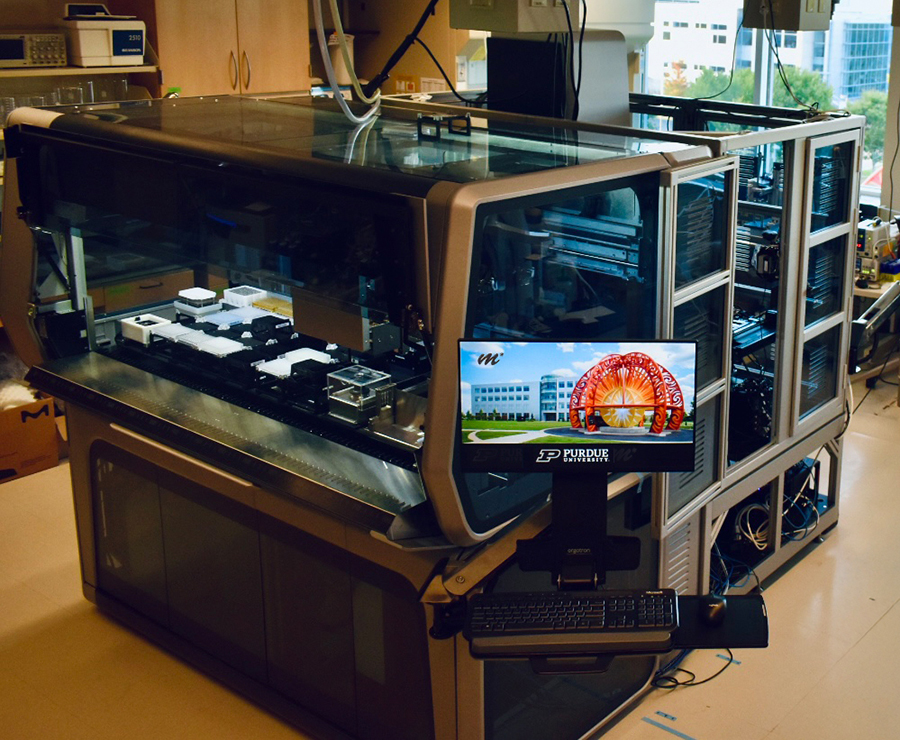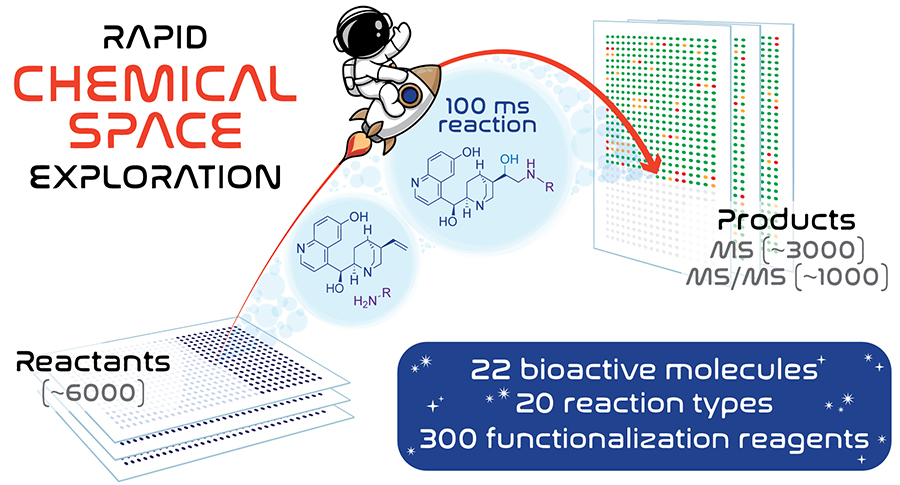Purdue chemists use DESI-MS to explore chemical space, accelerate reactions and impact drug discovery
2024-12-03
Writer(s): R. Graham Cooks, Steve Scherer
Purdue University is known as the "Cradle of Astronauts" for its 27 pioneering alumni who have explored space over the past half century.
A group of Purdue chemists is exploring space, too. In this case, they are down on Earth systematically analyzing the vast array of possible chemical compounds that scientists refer to as “chemical space.”
“Exploration is a key step in drug discovery. That is, finding compounds that have favorable effects on a disease,” said R. Graham Cooks, Henry B. Hass Distinguished Professor in the Tarpo Department of Chemistry.
Cooks and his research team rapidly explore chemical space by using acceleration (of course!) but reaction acceleration not physical acceleration. The chemists use a method with a ridiculously long name (high throughput desorption electrospray ionization mass spectrometry) or DESI-MS. They describe all this in the Journal of American Chemical Society.
“We analyze thousands of reactions and measure products at rates greater than one reaction per second. These reactions are not occurring in test tubes, or even in microwells. They occur in tiny, flying droplets, typically one micron in diameter, where reactions are accelerated by factors of up to one million,” Cooks added.
Cooks’ group developed the ultra-simple DESI-MS method where droplets of pure solvent are propelled against a surface. The droplets briefly wet the surface and dissolve compounds in a thin liquid film. As new solvent droplets impact this surface, their splashes release small secondary droplets containing the reagents. It is in these droplets that the reactions occur. The droplets can be directed into a mass spectrometer to identify the products or landed on a new surface for further study and bioassays.
“It is not an exaggeration to state that the major task in the pre-clinical phase of drug discovery involves the search for chemical analogs with better properties. The usual experiments to achieve this involve traditional organic synthesis, one compound being modified at a time and a wide range of reaction conditions being explored,” explained Cooks, who is also affiliated with the Purdue Institute for Cancer Research, Purdue Institute of Inflammation, Immunology and Infectious Disease (PI4D), Bindley Biosciences Center, and the Purdue Institute for Drug Discovery.
Cooks says the aim of this work is to demonstrate a faster route to drug discovery by modification of existing drugs – a time-consuming process in the pharmaceutical industry.
“Our approach shortens the time remarkably because we perform chemical reactions in tiny droplets where they go many thousands of times faster. This is why we are able to explore more chemical space – accessing more of the numerous compounds that are possible by simple changes to existing successful drugs,” said Cooks, who conceptualized and led the project.
The other members of the team involved in the research include Nicolás M. Morato, a former PhD student who led the construction of the high throughput instrumentation, along with chemist Kai-Hung Huang and graduate students Yunfei Feng and Alexis Toney.
This research was supported by National Institutes of Health, National Center for Advancing Translational Sciences (NIH/NCATS) and by Waters Corporation which has licensed the DESI technology and collaborated on the development of the new-generation platform.
A research facility has been established in Discovery Park (High Throughput DESI-MS) to provide Purdue and other scientists access to this new space technology.

Located in the Hall for Discovery and Learning Research (DLRC), the automated high throughput synthesis and reaction screening system was built in 2023-2024 at Purdue using components from Waters (Q-ToF mass spectrometer) and from Hamilton (Vantage Workstation) as well as Purdue customized software. Desorption electrospray ionization (DESI) a Purdue-developed method is used for reaction screening and bioassays of collected products. The system is distinguished from all other robotic chemical systems in that synthesis is performed in flying microdroplets where reaction acceleration (by orders of magnitude) allows multiple synthesis experiments to be done per second.
No test tubes or microwells here. Instead, the DESI source scans and analyzes a spot array plate that is about the same size as a small index card. Each spot contains about 5 nanogram of reagents on a standard plate of 6144 spots. (Click to enlarge image.)
About Purdue Chemistry
The Tarpo Department of Chemistry is internationally acclaimed for its excellence in chemical education and innovation, boasting two Nobel laureates in organic chemistry, the #1 ranked analytical chemistry program, and a highly successful drug discovery initiative that has generated hundreds of millions of dollars in royalties.
About Purdue University
Purdue University is a public research institution demonstrating excellence at scale. Ranked among top 10 public universities and with two colleges in the top four in the United States, Purdue discovers and disseminates knowledge with a quality and at a scale second to none. More than 105,000 students study at Purdue across modalities and locations, including nearly 50,000 in person on the West Lafayette campus. Committed to affordability and accessibility, Purdue’s main campus has frozen tuition 13 years in a row. See how Purdue never stops in the persistent pursuit of the next giant leap — including its first comprehensive urban campus in Indianapolis, the Mitch Daniels School of Business, Purdue Computes and the One Health initiative — at https://www.purdue.edu/president/strategic-initiatives.

